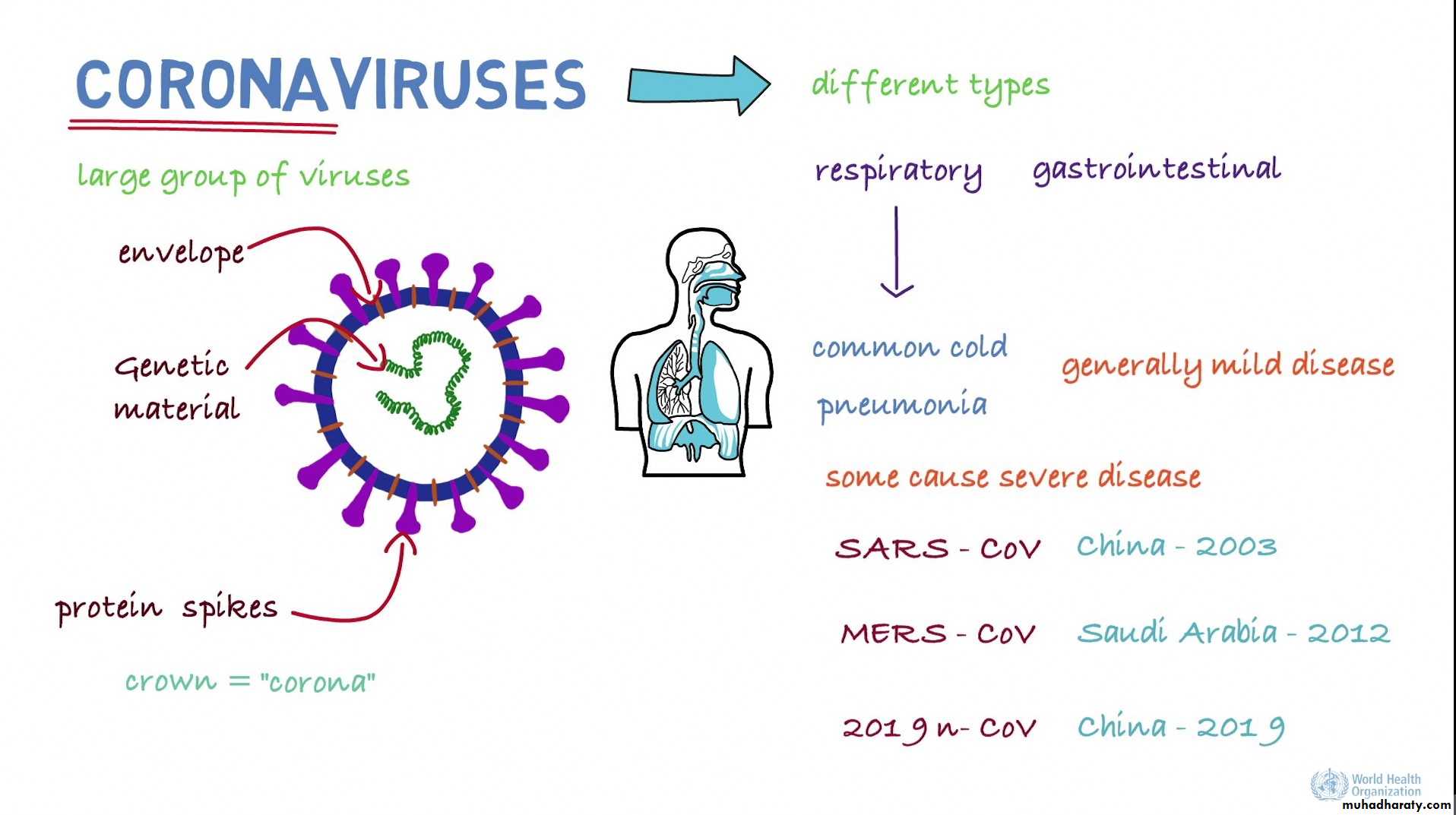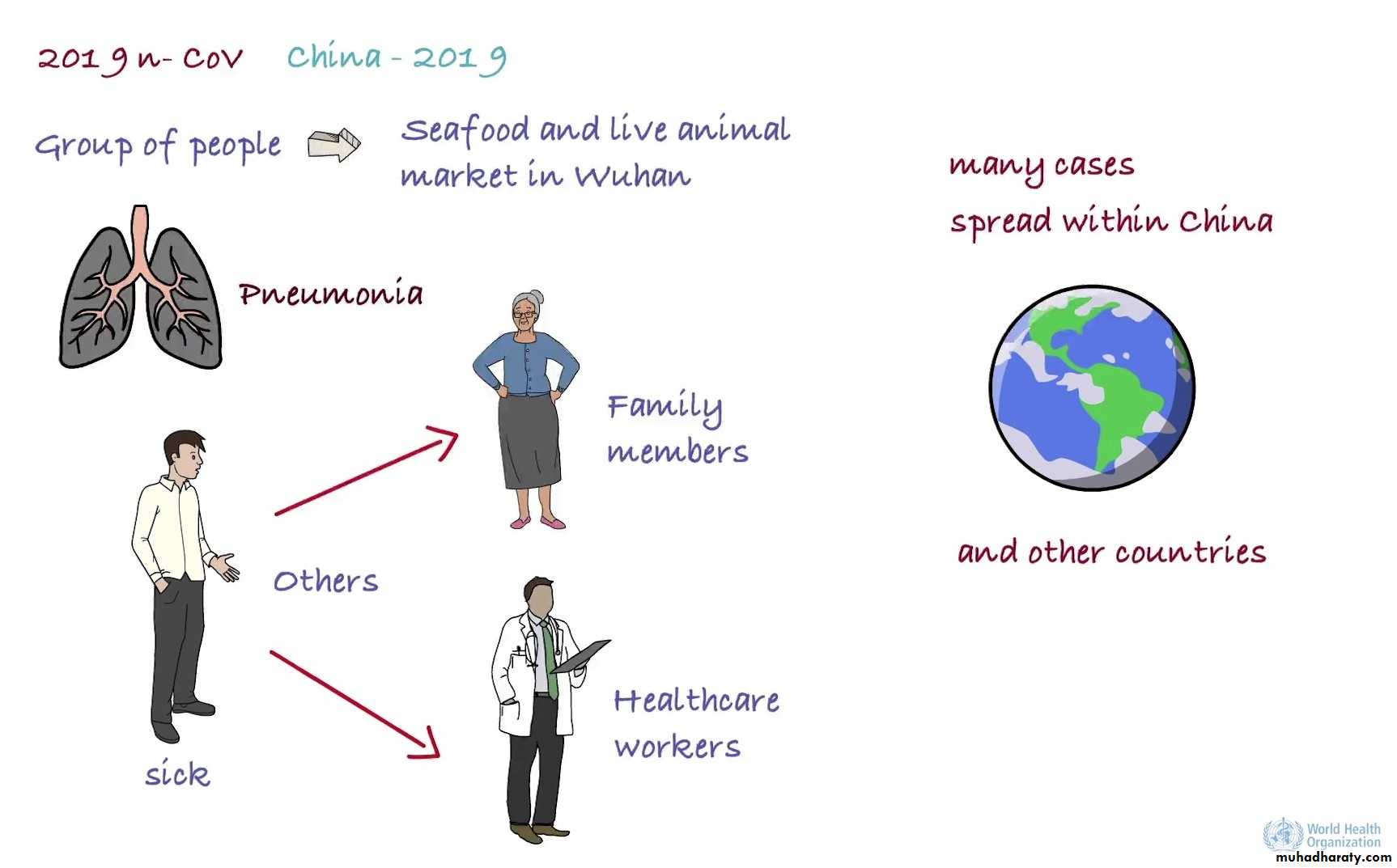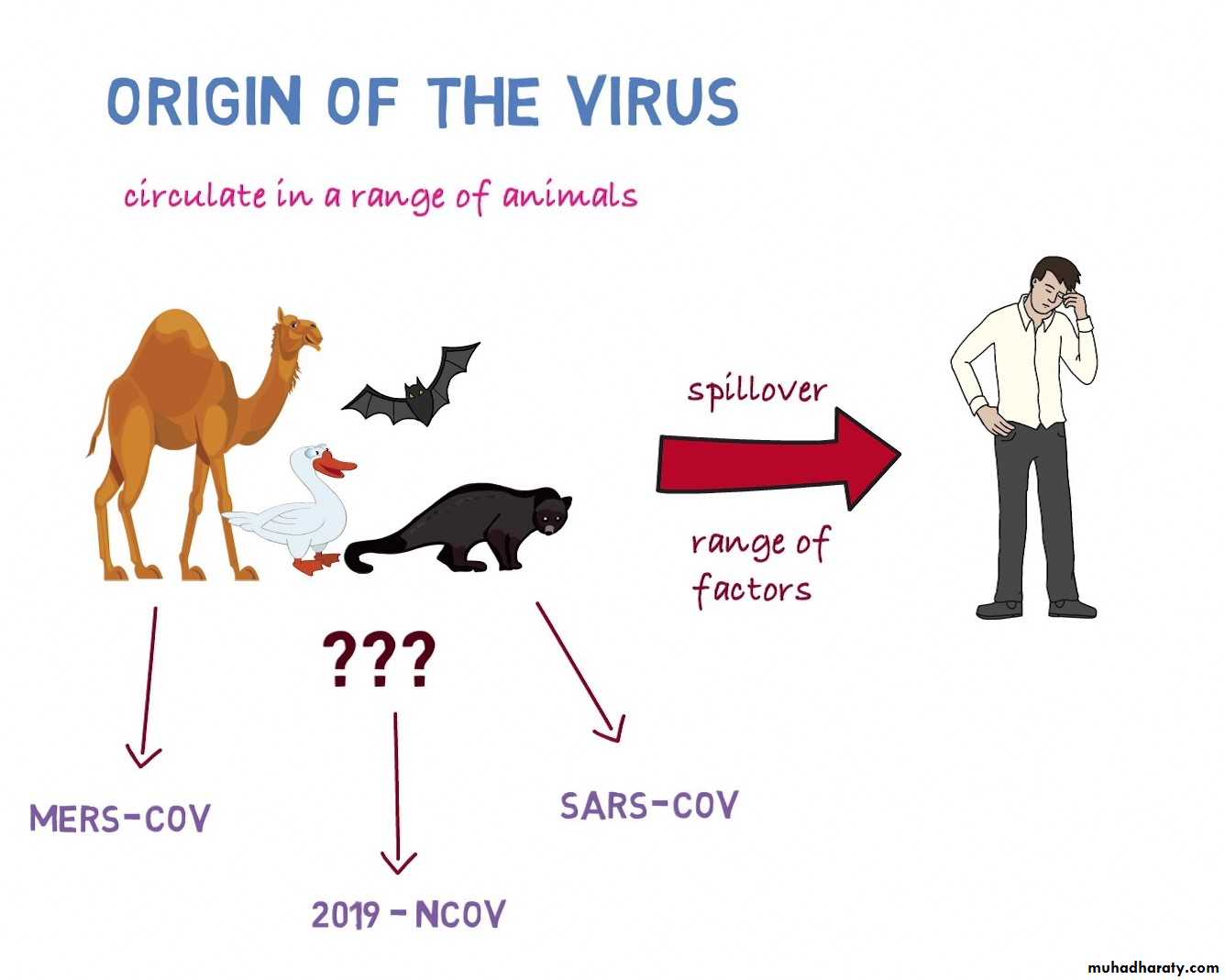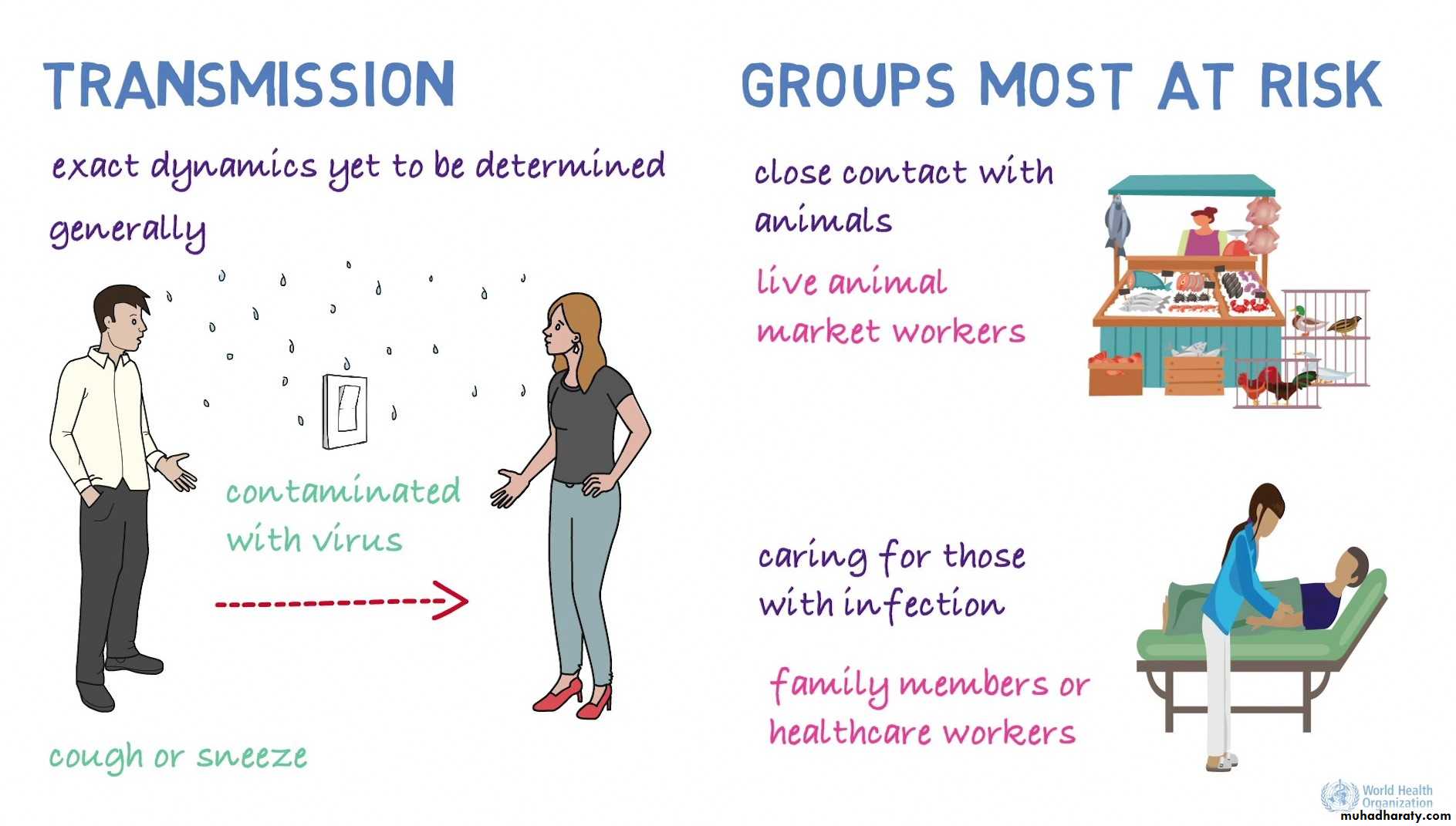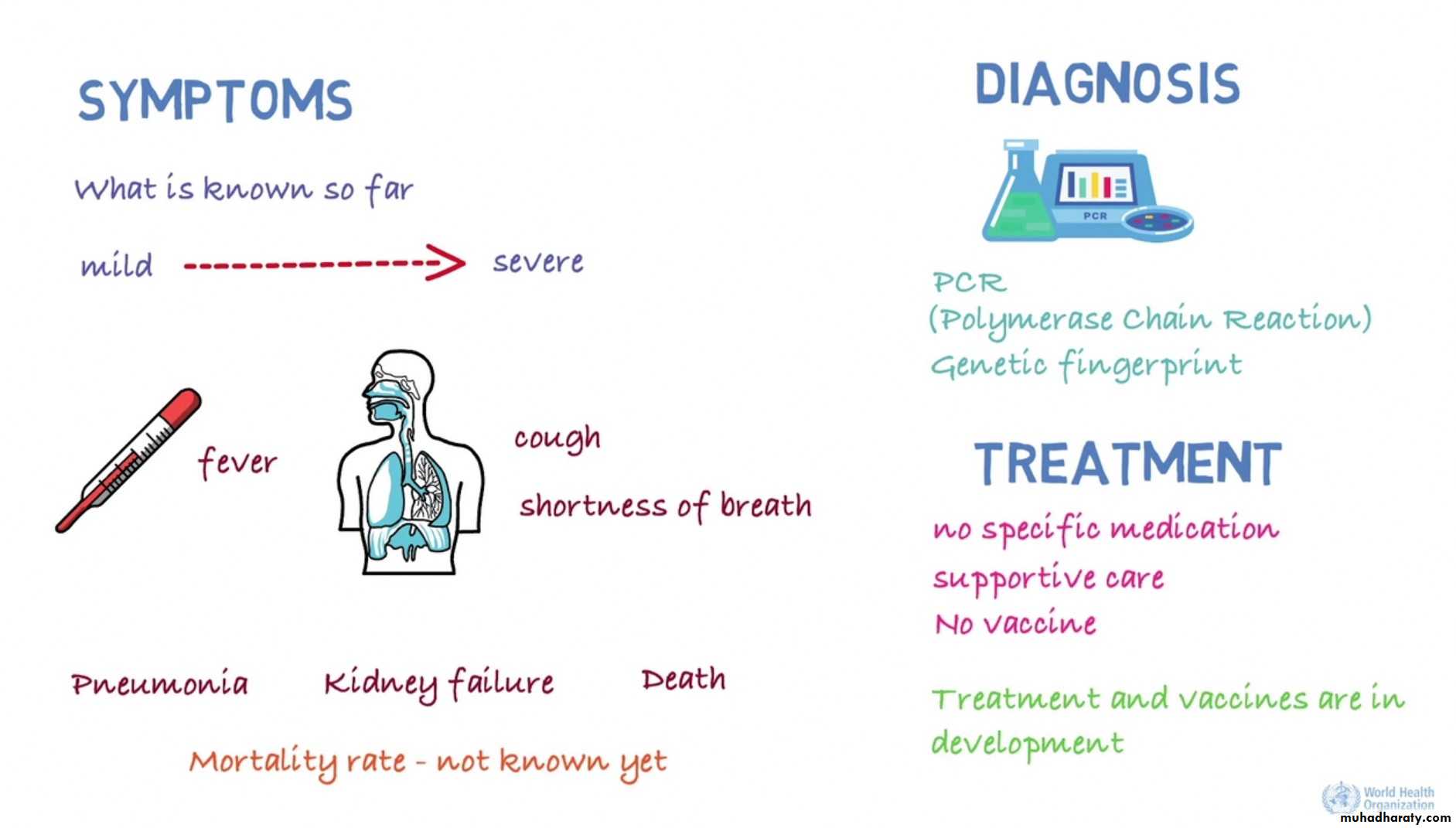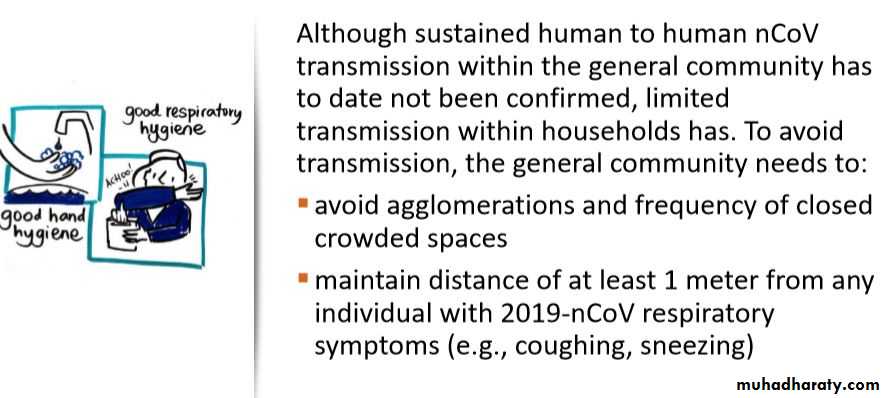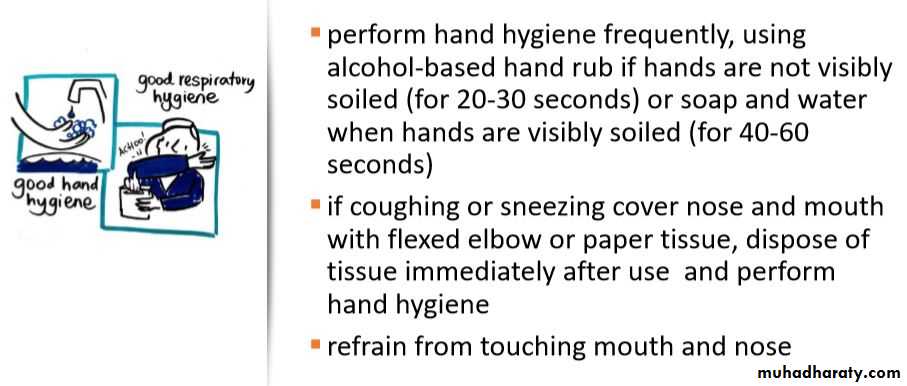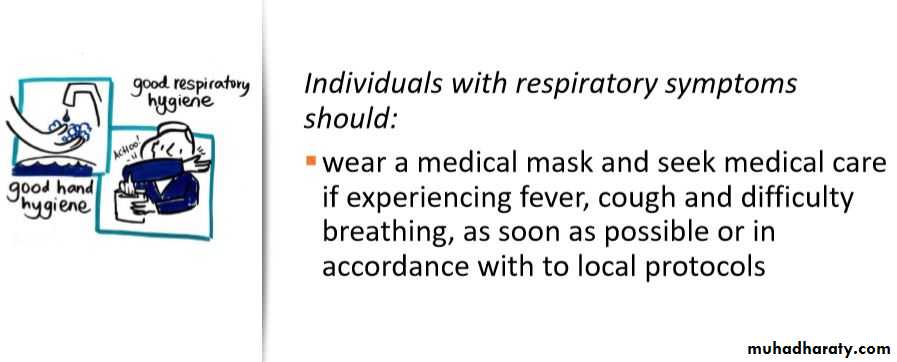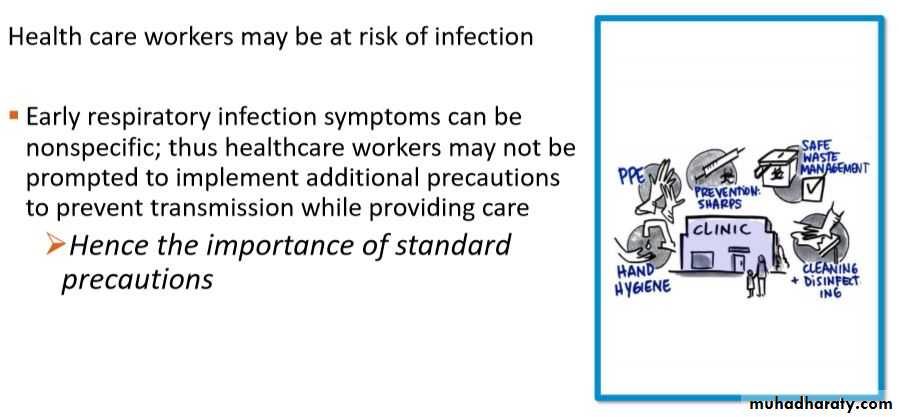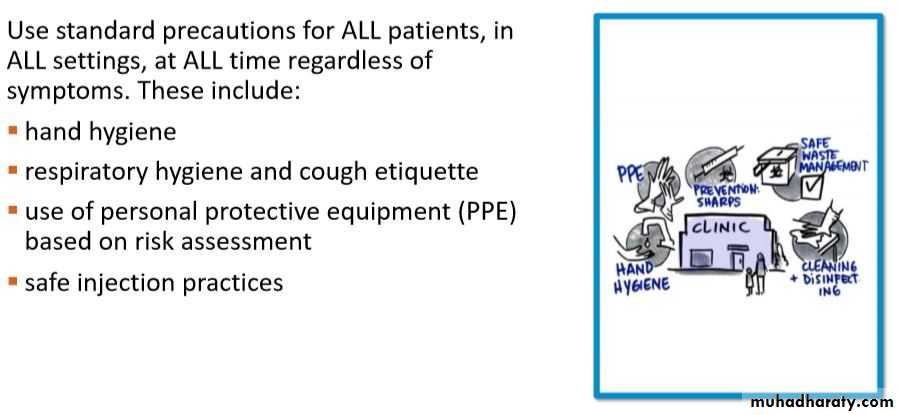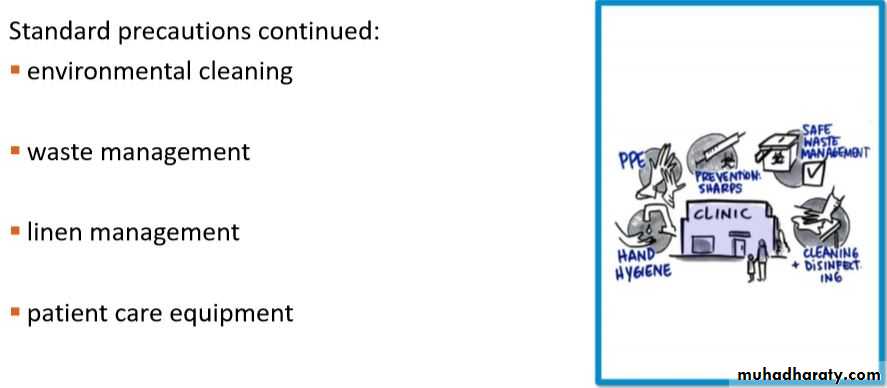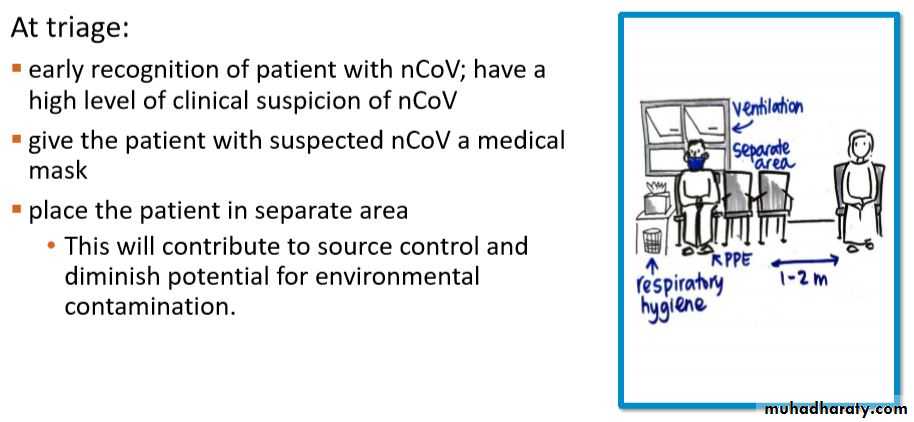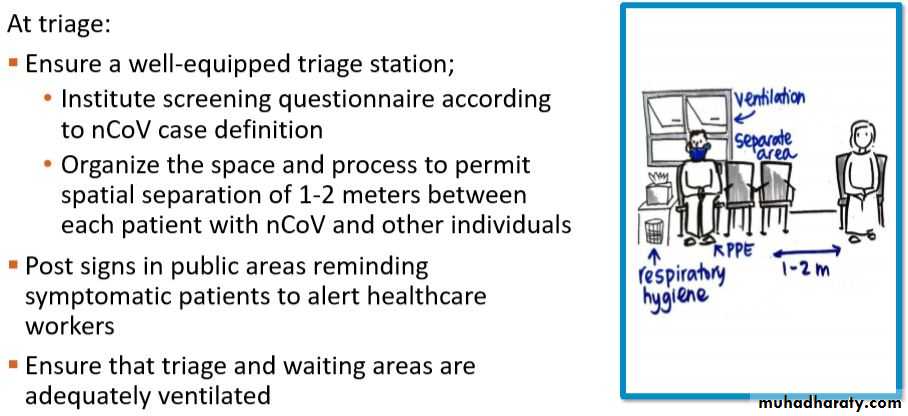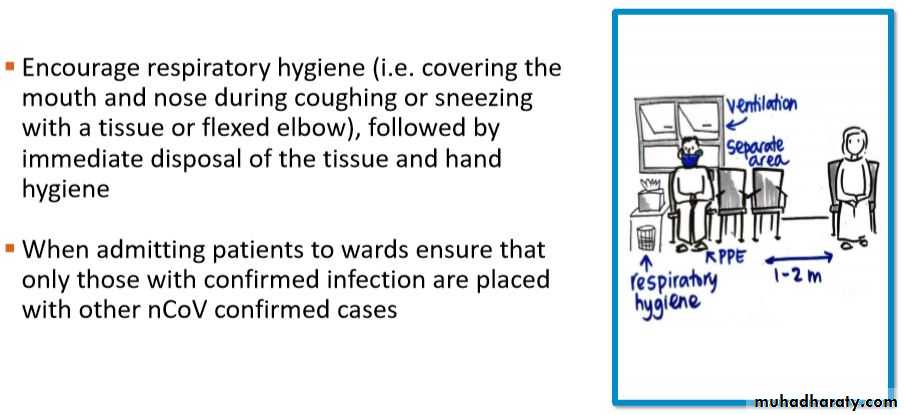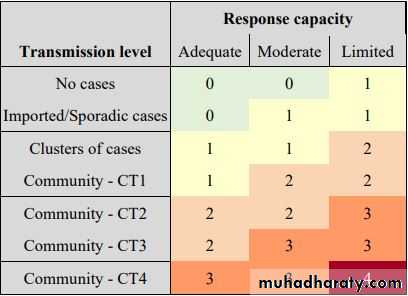Control of communicable diseasesRespiratory diseasesStage 4-L6
2019, novel Corona virusBy Dr. Muslim N. Saeed \ FAMCO dept.
Jan 20th , 2021
2019, novel Coronavirus
In December 2019, there was cluster of pneumonia cases in China. Investigations found that it was caused by a previously unknown virus – named the 2019, novel coronavirus.Now its called SARS-CoV-2 .
The disease is called COVID-19 .
Coronaviruses are a large group of viruses. They consist of a core of genetic material surrounded by an envelope with protein spikes. This gives it the appearance of a crown. Crown in Latin is called Corona. There are different types of coronaviruses that cause respiratory and sometimes gastrointestinal symptoms. Respiratory disease can range from the common cold to pneumonia and in most people, the symptoms tend to be mild. However, there are some types of coronaviruses that can cause severe disease. These include the Severe Acute Respiratory Syndrome Coronavirus, first identified in China in 2003 and the Middle East Respiratory Syndrome Coronavirus, that was first identified in Saudi Arabia in 2012. The 2019 novel coronavirus was first identified in China.
It initially occurred in a group of people with pneumonia who had been associated with a seafood and live animal market, in the city of Wuhan. The disease has since spread from those who were sick to others including family members and health care staff. There are many cases at present, and the disease has spread within China and also to a number of other countries.
So, where did the virus come from? It is known that coronaviruses circulate in a range of animals. Sometimes, these viruses can make the jump from animals to humans. This is called a “spillover” and could be due to a range of factors such as mutations in the virus or increased contact between humans and animals. For example, MERS CoV is known to be transmitted from camels and SARS CoV from civet cats. The animal reservoir of the 2019 novel coronavirus is not yet known.
How is it transmitted? The exact dynamics of how the virus is transmitted is yet to be determined. In general, respiratory viruses are usually transmitted through droplets created when an infected person coughs or sneezes or, through something that has been contaminated with the virus. People most at risk of infection from the novel coronavirus are those in close contact with animals such as live animal market workers and those who are caring for people infected with the virus such as family members or healthcare workers.
So how does the disease present? there can be a number of symptoms ranging from mild to severe. There can be fever and respiratory symptoms such as cough and shortness of breath. In more severe cases, there has been pneumonia, kidney failure and death. The mortality rate is not known yet. How can we tell whether someone is infected? The infection can be diagnosed by a test called PCR, or Polymerase Chain Reaction. This test identifies the virus based on its genetic fingerprint. There is currently no specific medication for this virus and treatment is supportive care. There is currently no vaccine to protect against this virus. Treatment and vaccines are in development.
How do we prevent transmission of the virus?
This new virus currently has a limited geographic spread. However, there are a number of standard hygiene practices that have been recommended to protect against infection and further spread. These include:• Covering your mouth and nose when coughing or sneezing with a medical mask, tissue or flexed elbow.
• Avoiding close contact with those who are unwell.
• the appropriate use of masks and Personal Protective Equipment (PPE) – especially in a health care setting.
• Washing hands regularly with soap and water or alcohol-based hand rub.
• It is important to stay home if you are feeling unwell, but if you have a fever, cough and difficulty breathing, seek medical care early and share your previous travel history with your health care provider.
• Actions that can be taken to prevent infection from an animal source include:
• Avoiding unnecessary unprotected contact with animals.
• washing hands after contact with animals or animal products.
• ensuring that animals products are cooked thoroughly before they are consumed.
Infection Prevention Control(IPC) for the general community
IPC measures to prevent transmission in health care settings
Considerations for implementing and adjusting public health and social measures (PHSM) in the context of COVID-19
-Public health and social measures (PHSM) are being implemented across the globe to limit transmission and reduce mortality and morbidity from COVID-19. PHSM include non-pharmaceutical individual and societal interventions to control COVID-19.
-(PHSM) have proven critical to limiting transmission of COVID-19 and reducing deaths.
• The decision to introduce, adapt or lift PHSM should be based primarily on a situational assessment of the intensity of transmission and the capacity of the health system to respond.
• PHSM must be continuously adjusted to the intensity of transmission and capacity of the health system in a country and at sub-national levels.
• When PHSM are adjusted, communities should be fully consulted and engaged before changes are made.
Transmission scenarios:
-Assessing the level of transmission is key to assessing the overall COVID-19 situation in a given area and therefore tailoring epidemic control measures.
-WHO previously defined four transmission scenarios to describe the dynamic of the epidemic:
1-no reported cases (including both zero transmission and the absence of detected and reported cases).
2-sporadic cases.
3-clusters of cases.
4-community transmission.
-With many countries now experiencing community transmission and seeking to adjust PHSM to various levels of intensity, an update of the transmission classification has been developed to provide more granularity.
-The community transmission (CT) classification is now divided into four levels, from low incidence (CT1) to very high incidence (CT4).
Consequently, there are now seven categories of transmission level classification:
1.No (active) cases.2.Imported / Sporadic cases.
3.Clusters of cases.
4.CT1: Low incidence of locally acquired widely dispersed cases detected in the past 14 days.
5.CT2: Moderate incidence of locally acquired widely dispersed cases detected in the past 14 days.
6.CT3: High incidence of locally acquired widely dispersed cases in the past 14 days.
7.CT4: Very high incidence of locally acquired widely dispersed cases in the past 14 days
Response capacity:
In addition to assessing the level of transmission, it is also necessary to understand the available health system response capacity–depending on whether there is adequate, moderate, or limited capacity, the same level of transmission can result in a drastically different situation and require a different degree of PHSM implementation. For the purposes of this document, ‘response capacity’ encompasses both clinical care and public health services, and is measured in terms of both the actual capacity (ability) to deliver services, and the performance of those services.Situational assessment using transmission level and response capacity
The decision to introduce, adapt or lift PHSM, or to scale up health system capacity, should be based on an analysis of the level of transmission, the health system response capacity, and other contextual factors.
The indicators should be monitored regularly (e.g. biweekly) and the Situational Level assessed accordingly to inform the appropriateness and impact of the PHSM measures taken and to anticipate future changes.
Situational Level assessment matrix using transmission level and response capacity indicators to guide adjustment of PHSM
1. Situational Level 0 corresponds to a situation with no known transmission of SARS-CoV-2 in the preceding 28 days. The health system and public health authorities are ready to respond, but there should be no restrictions on daily activities.
2. Situational Level 1 is a situation where basic measures are in place to prevent transmission; or if cases are already present, the epidemic is being controlled through effective measures around the cases or clusters of cases, with limited and transient localized disruption to social and economic life.
3. Situational Level 2 represents a situation with low community incidence or a risk of community transmission beyond clusters. Additional measures may be required to control transmission; however, disruptions to social and economic activities can still be limited.
4. Situational Level 3 is a situation of community transmission with limited additional capacity to respond and a risk of health services becoming overwhelmed. A larger combination of measures may need to be put in place to limit transmission, manage cases, and ensure epidemic control.
5. Situational Level 4 corresponds to an uncontrolled epidemic with limited or no additional health system response capacity available, thus requiring extensive measures to avoid overwhelming of health services and substantial excess morbidity and mortality.
Guidance on the implementation of PHSM for each level of severity
1. Situational Level 0At this level, surveillance should ensure that any new case can be detected and managed as early as possible, but there should be no restrictions on daily activities. the following measures considered:
a. Continue strengthening emergency preparedness and response, ensuring adequate medicines and medical equipment and that sufficient staff have been trained to handle anticipated surges in workload.
b. Individuals should apply basic individual precautionary measures and behaviours such as hand hygiene, cough etiquette, staying home / wearing a mask if unwell and voluntary physical distancing.
c. Robust surveillance to rapidly detect and investigate suspected cases and clusters and ensure public health measures such as isolation and quarantine are undertaken to reduce onward spread if cases are confirmed and contacts are traced.
d. Travel outside the area permitted.
e. Clear information should be provided to the public about what to do if unwell and whom to contact for advice, testing and/or treatment.
2. Situational Level 1
In addition to measures on emergency preparedness and response and surveillance, individual precautionary measures and risk communications, implementing the following measures:
a.Cases and cluster detection, investigation, tracking and tracing of contacts. b.Individual should apply individual precautionary measures and behaviours ………….
c. Promote avoidance of the ‘3 Cs’ – closed spaces, crowded places and close-contact settings.
d. Daily activities and services, such as educational settings, businesses and leisure/tourism can remain open with safety measures in place to limit the risk of spread.
e. Measures should be in place to protect the most vulnerable, particularly ensuring that there are appropriate measures in place in long-term care13 and other residential facilities.
3. Situational Level 2
Implementing the following measures:a.Education settings remain open with infection prevention and control (IPC) measures in place.
b.Businesses remain open, with safety measures in place, with teleworking encouraged as much as possible.
c.Individual should apply individual precautionary measures and behaviours ……….and avoiding the ‘3C’s’ – ………….
d.Limit the size of social and other mass gatherings.
e.Protecting the most clinically vulnerable, through strict application of PPE and IPC measures, heightened surveillance and managing visits in long term care and other residential facilities.
4. Situational Level 3
All individuals should reduce their social contacts, and some activities may need to close while allowing for essential services and in particular schools to remain open. In addition to measures on emergency preparedness and response and surveillance, the following measures should be considered:a.Closure of non-essential businesses or remote working as much as possible.
b.Individual should apply individual precautionary ….and avoiding the ‘3C’s’ – ...
c.Consider limiting in-person university teaching, and institute e-learning.
d.Childcare services and primary and secondary schools should remain open with adequate safety and surveillance measures in place as long as the local context allows. Continuity of education for children for their overall well-being, health and safety should be at the forefront of all relevant considerations and decisions.
e.Evaluate holding sporting and similar events, using a risk based approach; if held, they should be held under strict safety rules, e.g. without spectators. Other mass gatherings should be suspended, and the size of all social gatherings should be decreased.
5. Situational Level 4
In addition to measures on emergency preparedness and response and surveillance, individual precautionary measures and risk communications, the following measures considered:
-Individuals should stay at home and limit social contact with people outside the household.
-Essential workers will need to continue activities, with maximum support and safety measures in place.
-Closure of non-essential businesses or remote working.
-Consider all options for continuity of in-person learning. If not possible, limit in-person contact. This may include in person teaching, blended or remote learning strategies that strictly limit the number of people physically on site (exceptions would include children of essential workers and their teachers). The closure of educational facilities should only be considered when there are no other alternatives.
-All long-term care and other residential facilities should consider strict measures to limit the risk of infection, such as prohibiting in-person visitors.

